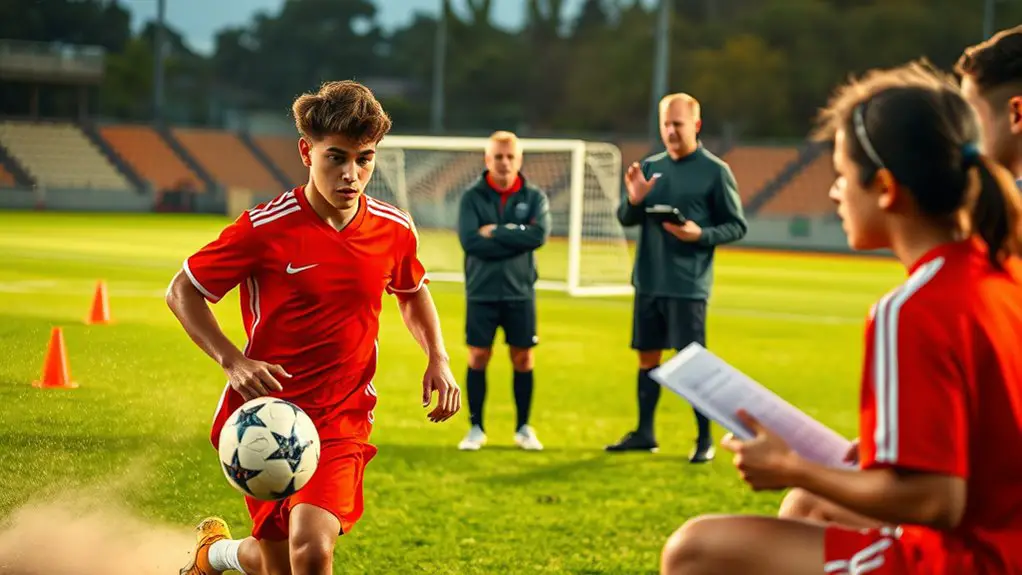To improve your pitching velocity safely, focus on mastering your mechanics and building core and lower body strength. Incorporate plyometric exercises to boost explosive power, and don't overlook flexibility through dynamic and static stretching. Prioritize proper warm-up and cool-down routines, including post-throw stretching for recovery. Additionally, maintain a balanced diet and hydration to support muscle health. With these strategies in place, you'll enhance your performance, and there's even more to explore on injury prevention and recovery techniques.
Understanding Pitching Mechanics
When you understand pitching mechanics, you'll release the potential to throw harder and more accurately. Mastering your throwing motion is all about freedom—freedom to express your skills without the constraints of bad habits. Start with focused pitching drills that target specific aspects of your form, like arm angle and follow-through. These drills help reinforce the proper mechanics, allowing you to feel the difference in your delivery.
Incorporating biomechanics analysis can provide deeper insights into your pitching style. By examining your body movements and energy transfer, you can identify areas for improvement that might not be obvious. This analysis helps guarantee you're using your body efficiently, maximizing your power while minimizing injury risk. Embrace this process, and you'll discover how refining your mechanics not only boosts your velocity but also enhances your overall confidence on the mound. Additionally, integrating strength training exercises into your routine can significantly improve your pitching performance.
Building Core and Lower Body Strength
To boost your pitching velocity, focusing on core stability and lower body strength is essential. Strong muscles in these areas not only enhance your power but also improve your balance and control on the mound. Incorporating targeted exercises and proper stretching techniques into your routine can make a significant difference in your performance. A well-conditioned core helps prevent injuries by stabilizing the spine during exertion.
Importance of Core Stability
Core stability plays an essential role in enhancing your pitching velocity. When you focus on core engagement, you're laying the foundation for power and control in your throws. Stability training strengthens the muscles that support your spine and pelvis, allowing you to generate more force while remaining balanced. This balance is key; it helps you transfer energy efficiently from your lower body through your core and into your pitch. By prioritizing your core strength, you'll not only improve your performance but also reduce the risk of injury. Incorporating exercises that target core stability will give you the freedom to pitch with confidence, knowing you're using your body effectively. Embrace this journey to elevate your game!
Lower Body Exercises
Building on the foundation of core stability, strengthening your lower body is essential for enhancing pitching velocity. By incorporating squat variations like front squats and split squats, you'll increase power in your legs, which translates into a stronger pitch. These exercises not only build muscle but also improve your balance and coordination, giving you more freedom to move dynamically on the mound.
Additionally, lunges offer tremendous benefits, promoting flexibility and stability in your hips. They help develop the explosive strength needed for powerful pitches. By focusing on these lower body exercises, you're not just building strength; you're creating a solid foundation that supports your entire pitching motion. Embrace these movements, and you'll see your velocity improve without sacrificing safety.
Proper Stretching Techniques
While you might focus on strength training, proper stretching techniques are equally essential for enhancing both core and lower body strength. To maximize your pitching velocity, integrate dynamic stretches into your warm-up routine. Movements like leg swings and arm circles improve blood flow and enhance flexibility, preparing your body for explosive action. After your workout, shift to static stretches to cool down. Holding stretches like the quadriceps stretch or hamstring stretch for 15-30 seconds helps lengthen your muscles and promote recovery. This balanced approach not only increases your range of motion but also reduces the risk of injury. Embrace these techniques, and you'll experience greater freedom in your pitching performance while building the strength you need for success.
Incorporating Plyometric Exercises
Incorporating plyometric exercises into your training can greatly boost your pitching velocity. These explosive movements not only enhance your power but also improve your overall athletic performance. However, it's essential to understand the benefits, select the right exercises, and follow safety precautions to avoid injury. Additionally, plyometrics focus on improving nervous system efficiency, allowing for a faster muscle response that can contribute to increased pitching velocity.
Benefits of Plyometric Training
Plyometric training can greatly boost your pitching velocity by enhancing explosive power and strength. By incorporating these dynamic exercises, you'll tap into your body's natural ability to generate force quickly, leading to faster pitch speeds. The plyometric benefits extend beyond just power; they also improve coordination and agility, enabling you to harness your movements more efficiently on the mound. You'll find that with improved explosive power, your overall performance can soar, giving you the edge against batters. Plus, as you engage in plyometrics, you'll build a solid foundation of strength, which is essential for injury prevention. Embrace this training method, and you'll experience not just a surge in velocity but also a newfound freedom in your pitching game.
Recommended Plyometric Exercises
To maximize the benefits of plyometric training for improving your pitching velocity, it's important to choose the right exercises. Incorporating jump training and explosive movements into your routine can greatly enhance your performance. Here are some recommended plyometric exercises to take into account:
| Exercise | Description |
|---|---|
| Box Jumps | Jump onto a sturdy box for height. |
| Depth Jumps | Step off a box and jump upon landing. |
| Medicine Ball Slams | Explosively slam a ball to the ground. |
| Broad Jumps | Jump forward as far as you can. |
| Tuck Jumps | Jump and bring your knees to your chest. |
These exercises not only boost your power but also help in developing agility. Embrace the challenge and let your pitching velocity soar!
Safety Precautions to Consider
While plyometric exercises can greatly enhance your pitching velocity, it's important to prioritize safety to prevent injury. Begin each session with effective warm-up strategies to prepare your muscles and joints. Dynamic stretches and light jogging can get your blood flowing and reduce the risk of strains. Incorporate proper techniques when performing plyometrics; don't rush through movements. Focus on form over speed, and listen to your body—if something feels off, take a break. Gradually increase the intensity and volume of your workouts to allow your body to adapt. Finally, make sure you include recovery days in your training routine; they're vital for injury prevention and will help you maintain peak performance without overdoing it.
Developing Arm Care Routines
Establishing a solid arm care routine is essential for any pitcher aiming to enhance performance and prevent injuries. You've got to prioritize routine consistency, which means sticking to your plan day in and day out. Start with a proper warm-up to get your muscles ready. Incorporate exercises focused on both strength and endurance, like band work and light weights, to build a resilient arm. Don't forget to include recovery days; they're as important as your workouts. Always listen to your body—if something doesn't feel right, take a step back. Hydration and nutrition play a significant role, too, so fuel your body with what it needs. Additionally, proper nutrition strategies are vital for enhancing recovery and muscle repair. By committing to a consistent arm care routine, you're not just protecting yourself; you're setting yourself up for greater success on the mound. Embrace this process, and you'll notice improvements in your velocity while keeping your arm healthy.
Focusing on Flexibility and Mobility
As you work on improving your pitching velocity, don't overlook the importance of flexibility and mobility. These elements are vital for a fluid, powerful pitching motion. Incorporating dynamic stretching and yoga practices into your routine can enhance your range of motion, helping you to pitch more effectively and safely. Additionally, improving injury risk reduction through consistent mobility training can empower you to explore new pitching techniques without fear.
| Dynamic Stretching | Yoga Practices | Benefits |
|---|---|---|
| Arm Circles | Downward Dog | Strengthens shoulders |
| Leg Swings | Warrior II | Increases hip flexibility |
| Torso Twists | Cat-Cow Stretch | Improves spinal mobility |
| High Knees | Child's Pose | Enhances relaxation and focus |
Implementing Effective Warm-Up and Cool-Down Practices
A solid warm-up and cool-down routine is essential for any pitcher looking to boost their velocity and reduce injury risk. Start with dynamic stretching to get your blood flowing and loosen those muscles. Think leg swings, arm circles, and torso twists—these movements will not only enhance your range of motion but also prep your body for the demands of pitching.
After your throwing session, don't skip your post-throw routines. These are vital for recovery and maintaining flexibility. Spend time on static stretches that target your shoulders, back, and legs. This helps relieve tension built up during pitching and promotes blood flow to aid in recovery. Additionally, incorporating post-workout stretches can further enhance your flexibility and support the recovery process.
Also, consider incorporating foam rolling to address any tight spots. By implementing these warm-up and cool-down practices consistently, you'll not only improve your performance but also protect yourself from potential injuries, giving you the freedom to pitch at your best.
Prioritizing Recovery and Injury Prevention
While it's easy to focus solely on increasing pitching velocity, prioritizing recovery and injury prevention is equally essential for long-term success. If you want to maintain your freedom on the mound, incorporating effective recovery techniques can make all the difference. Here's how to safeguard your pitching future:
- Active Recovery: Engage in light activities like jogging or swimming to promote blood flow without straining your arm. This approach enhances blood flow and recovery, which is crucial for muscle healing.
- Stretching: Incorporate dynamic stretching pre-game and static stretching post-game to enhance flexibility and reduce tightness.
- Rest: Verify you're getting adequate sleep and taking days off. Your muscles need time to heal and rebuild.
- Nutrition: Fuel your body with a balanced diet rich in proteins, vitamins, and minerals to support muscle recovery and injury prevention.
Frequently Asked Questions
How Does Nutrition Affect Pitching Velocity and Performance?
You might think munching on junk food before a game is the secret to pitching success, right? Well, not quite! Proper nutrition timing and hydration strategies play an essential role in your performance. Fueling your body with the right nutrients at the right times keeps your energy up and helps maintain focus. Staying hydrated prevents fatigue, allowing you to release your true potential on the mound. So, ditch the junk and embrace the freedom of smart eating!
What Role Does Mental Focus Play in Improving Pitching Velocity?
Mental focus plays an essential role in enhancing your pitching velocity. When you use mental visualization techniques, you can picture yourself executing perfect pitches, which sharpens your concentration. Focus techniques, like mindfulness or breathing exercises, help you stay present and block out distractions. By harnessing these strategies, you'll not only boost your confidence but also find that your body responds better, allowing you to achieve greater velocity with each throw.
Are There Specific Drills for Increasing Velocity in Younger Pitchers?
When it comes to increasing velocity in younger pitchers, you can't just throw caution to the wind. Focus on drill variations that cater to their age and physical maturity. Simple exercises like long toss, weighted balls, and mechanics drills can help. Keep it fun and engaging to encourage their passion for the game. Remember, adjusting drills based on their development is key to ensuring they grow strong and confident on the mound.
How Can Weather Conditions Impact Pitching Velocity?
Weather conditions can greatly impact your pitching velocity. For instance, high humidity effects can make the air feel heavier, which might slow down your pitches. On the other hand, temperature variations can also play a role; warmer air can allow the ball to travel faster, while colder temperatures might decrease your velocity. Understanding these factors can help you adapt your technique and maximize your performance, giving you the freedom to excel on the mound.
What Are the Signs of Overtraining in Pitchers?
Have you ever wondered if you're pushing yourself too hard on the mound? Signs of overtraining in pitchers include persistent fatigue indicators like decreased performance, increased soreness, and mood changes. If you find yourself struggling to maintain your usual energy levels, it might be time to rethink your approach. Implementing effective recovery strategies, like proper rest and nutrition, can help you regain that freedom to pitch at your best without risking burnout.




